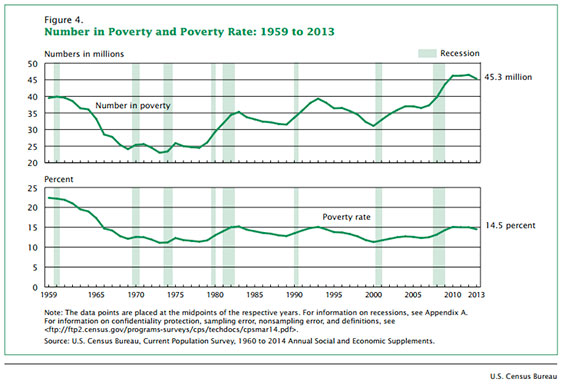In what passes for good economic news these days, the Census reported today that at the end of 2013, the U.S. no longer had a record number of people living in poverty. Only 45.3 million U.S. citizens were living below the poverty line as of that time, down from 46.5 million the year before.
Much of the drop was attributable to a nearly two-percentage point decline in the number of children living in poverty.
That said, it isn’t as though the 2013 numbers denote some stunning victory over poverty. The percentage of Americans living in poverty fell only half a percentage point, from 15 percent to 14.5 percent, and the 45.3 million individuals below the line still represent a historically huge number. In 1980, the number of Americans living in poverty was below 25 million.
Related: States Are Defrauding the Feds on Medicaid Payouts
In percentage terms, the poverty rate in the U.S. has tended to fluctuate between 11 and 15 percent for nearly 50 years. The Great Society programs implemented in the 1960s brought the rate down from the mid-20s, but through seven recessions and several economic booms since then, the poverty rate has stayed persistently within that 11-to-15 percent band.

The data presented by the Census on Tuesday does not take into account the substantial economic progress the country has made, particularly in terms of job creation, in 2014. The surest path out of poverty is, not surprisingly, a good job.
Related: Why So Many Americans Believe the Recession Never Ended
Jason Furman, the chair of the White House Council of Economic Advisers, and Betsey Stevenson, a member of the Council, wrote in a blog post Tuesday, “[T]here is reason to believe that this progress has continued into 2014, as the labor market has strengthened and millions have gained health insurance coverage. At the same time, the data also offer a clear illustration of the large amount of work that remains to strengthen the middle class in the wake of the worst recession since the Great Depression.”
However, the sheer volume of people living in poverty is such that progress in bringing the rate down is something likely to happen only incrementally. And if history is any guide, that’s something that current policies and programs can only accomplish up to a point – the best-case scenario being around 11 percent.
Non-Hispanic whites continued to be the least likely to live below the poverty line, appearing there at a rate of 9.6 percent. Hispanics, at 23.5 percent, were more than twice as likely as whites to be poor, while blacks, at 27.2 percent, were closer to three times as likely to live in poverty.
Women, at 15.8 percent, remain more likely to be poor than men, at 13.1 percent.
Top Reads from The Fiscal Times:




